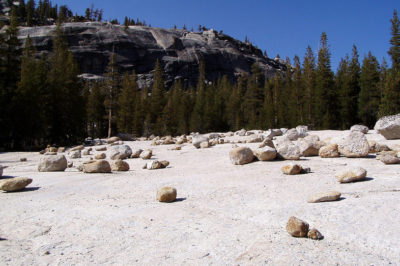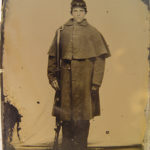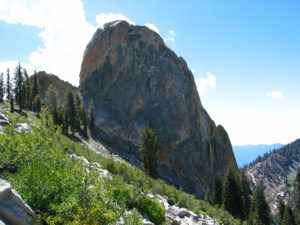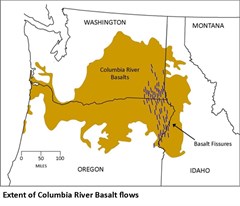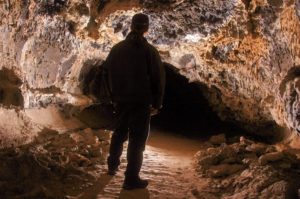This web resource supplements the audiobook on Librivox.org, “Mountaineering in the Sierra Nevada,” by Clarence King as read by Melanie Schleeter McCalmont. All Librivox recordings are in the public domain. This webpage resource is copyright the author.
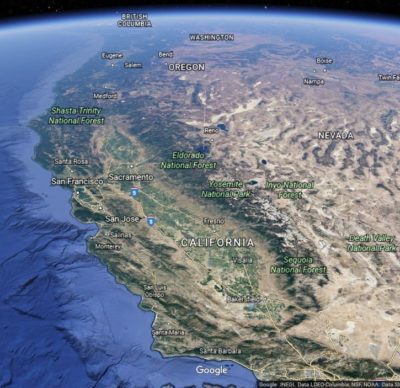
The Sierra Nevada range in the western United States. Clarence King’s book covers points in nearly all of this view. Image from Google Earth. Click image for interactive map.
About this resource
Clarence King was a young, adventurous geologist when his memoir “Mountaineering in the Sierra Nevada” was published in 1872. He was part of the Victorian wave of mountain-climbing that first scaled the highest world peaks in the mid-19th century and, as a scientist, was part of a similar wave of new theories and discoveries: Darwinian evolution, glaciers, volcanism, erosion, earthquakes, mapmaking, and human behavior.
While listening to this historic book, your appreciation will be greatly enhanced by contextual photos of a geologic feature, special word, 1860’s cultural reference that King mentions in his book.
The language used by King was chosen carefully for print readers, and includes detailed color and shape descriptions that now are replaced by color photographs. Because books were also read aloud to others as entertainment, you’ll find that King’s book exhibits a modern sense of timing and humor, and his accounts of hand-and-foot rock climbing seem as fresh as last week’s blog post.
For other general geologic terms not listed on my page, please see these two publications:
- USGS 2004-1216 Glossary of Glacier Terms, and
- USGS Geologic Glossary
- Interactive Geologic Map of California
- Reference Place Names of the High Sierra
Please! — Add your comments to this page if you have traced King’s mountaineering paths or have accounts of certain spots he mentions. Should you have a photo to share, either submit the web link or contact me for an upload. Most photos shown come from the rich resources of the U.S. government.
“Mountaineering in the Sierra Nevada” by Clarence King (1872)
Chapter 1 – The Range
Sierra Nevada – At audiobook 00:58. A mountain range in eastern California that defines much of the state’s economy, character, and water resources. Yosemite National Park, which King would go on to survey in Chapter 7, is located in the middle of the map at top.
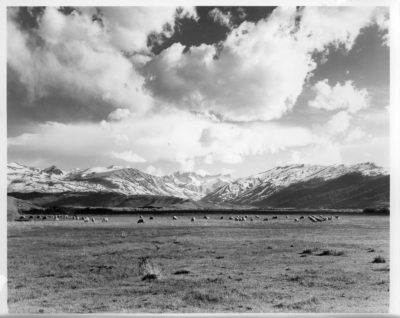
A ranch in Mono County, California, showing the eastern slope of the jagged, snowy Sierra Nevada range. Image from NRCS historical image galley.
Professor Whitney – At audiobook 01:41. An early California State Geologist from 1860-1873, Josiah Dwight Whitney led the earliest scientific surveys of California. Clarence King was a member of the California survey staff.
Development geologists – At audiobook 07:09. King here is referring to various factions of geologists that in the struggle to separate religion from science in the 19th century divided into factions of how, and how fast, the earth’s surface changed, either catastrophism (sudden worldwide change) or uniformitariansim (slow and even change).
Zauberflöte – At audiobook 09:09. German for “Magic Flute,” and King is referencing the plot of Mozart’s opera.
White teeth – At audiobook 11:27. In Spanish, “sierra” means “serrated, jagged” as in the teeth of a saw and “nevada” is “snowy.” Hence, King refers to the snowy, jagged blade-teeth of the range.
Parterres – At audiobook 22:02. A formal flat garden or water bed crossed and enclosed by paths, edging, or ornamentation. To see examples, search for ‘pareterre’ under the images section of any search engine.
Aiguilles – At audiobook 24:42. French for “needle.” In geology, describing mountain peaks that seem needle-like in their width, height, and sharpness.
Afflatus – At audiobook 37:58. Latin term meaning generally “the breath of divine inspiration.” This was a sarcasm directed at Gardner’s willful mule.
About’s “Man with the Broken Ear” – At audiobook 40:33. King refers to a popular French novel of the time by Edmond About in which the character Fougas is dessicated (dried out) after death and then brought back to life. You can see this text at the Project Gutenberg book link, Page 57, or search for the word “dessicated.”
Fil-a-ree flower – At audiobook 53:38. The filaree (Erodium botrys) is a purple wildflower common in the Yosemite region.
Chapter 2 – Through the Forest
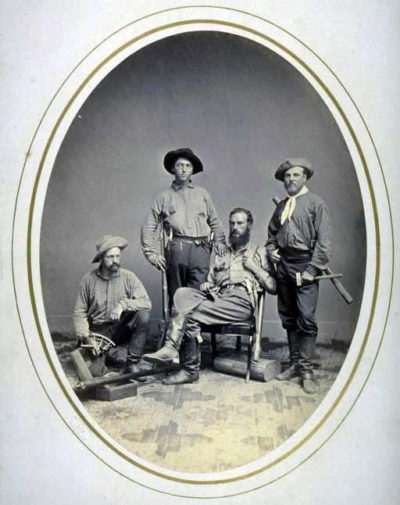
Field Party of 1864, L-R: James T. Gardner, Richard Cotter, Prof W. H. Brewer (seated), Clarence King. Image from the The Bancroft Library, University of California, Berkeley.
Charles F. Hoffman – At audiobook 00:46. Hoffman was a German topographer who was a longtime employee of the California Geological Survey under Whitney. He was also a professor of topography at Harvard University and is mentioned as a forefather of topography in the U.S. in Professor Brewer’s memoir “Up and Down California.”
The Field Party of James T. Gardner, Richard Cotter, William H. Brewer, and Clarence King – At audiobook 01:24. The men in the field party were employees of the California Geological Survey under Professor Whitney. The party is pictured at right.
Jan Hoesch – At audiobook 01:52. The spelling of the Danish name read aloud.
Umbrageous – At audiobook 10:11. Here meaning spotted with shadows, mottled shade.
Thomas’s Saw-Mill Ranch – At audiobook 11:18. A sawmill at the head of Uvas Creek in Santa Clara County, California.
Glacis – At audiobook 12:14. A low-angle sloping apron or embankment. Geographically, a bank of earth in front of a counterscarp (wall), having an easy slope toward the field or open country.
Digger Indians – At audiobook 25:23. An old nickname for the Maidu Indian people of the Sierra region, whose diet included of roots.
“The Indian Question” – At audiobook 36:12. From this early memoir on, King often explored the question of race in his writing, and in his daily life.
Sequoia gigantea – At audiobook 36:38. This tree is now classified as sequoiadendron giganteum . The trees that King witnessed are still standing today.
Trovatore hat – At audiobook 47:01. Trovatore means “troubadour” in Italian. This style of soft hat was seen in the Verdi opera “Il Trovatore” that was about 10 years old at the time.
Pike-Countian – At audiobook 47:09. A man from Pike County, Missouri named for Zebulon Pike, discoverer of Pike’s Peak, Colorado. Pike County also exists in Illinois, Kentucky, and Arkansas. In Kentucky, where this fellow was from, was known for its rough-and-tumble outdoor types. In Missouri at the time, they raised only more hogs than Iowa and had more mules than Texas.
Compound moraine – At audiobook 52:56. Now called an “interlobate moraine” or hilly lines of rock and debris that form where two lobes of a glacier meet. The Kettle Moraine in Wisconsin is a prime example, and the definition is on the Ice Age Trail website under “kettle moraine.”
Chapter 3 – The Ascent of Mount Tyndall
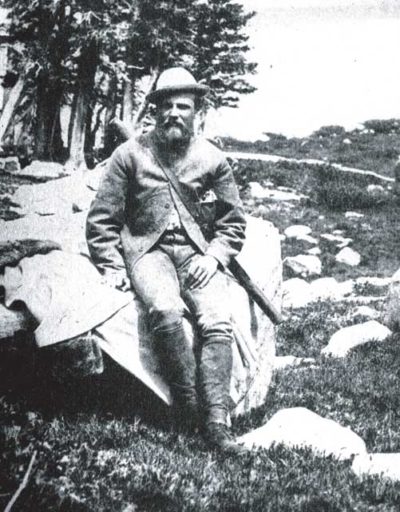
Clarence King with mercury barometer. Photo from Western Region Outreach, USGS.
Mount Tyndall – At audio book 00:00. King and Cotter climb the peak of 14, 015 feet. Clarence King and Richard Cotter ascend a new 14er and name it Mount Tyndall in honor of the British scientist, Sir John Tyndall. Tyndall was both a mountaineer and a student of glacier theory, and through his 1860 book “The Glaciers of the Alps” he would have been well-known to geologists of the day. For a modern climb account with excellent photos, see Field of Adventures Mount Tyndall page.
Hobnails – At audiobook 05:39. A short nail with larger studded head that was attached in a pattern to boot bottoms for traction. For photos and a modern account see this page.
Setting the minimum – At audiobook 24:49. When using barometers of the day, the daily measurement was re-set so that you could track the lowest temperature recording over time. Resetting the minimum was a matter of removing the thermometer form its mount, turning it upside down with the bulb at the top, and allowing the internal pin in the mercury to fall back to the bottom. If you are interested in barometers and thermometer instruments of the day, read a British handbook for instrument readings of approximately the same time period.
Regelation – At audiobook 27:59. The process by which ice melts faster under pressure, and by which two melting ice blocks stick together when the melting sides are in contact,
Sufficient unto the day – At audiobook 48:15. This partial saying from the bible’s Sermon on the Mount, and in use during King’s time as a warning to take life as it comes, or alternately to remain cheerful and not add further bad onto a day that already has its share. See the wikipedia page on this saying. King uses it when they are faced with a seemingly impossible climb and choose to go ahead anyway.
Rip Van Winkle Third Act – At audiobook 51:10. Rip Van Winkle was a popular short story by Washington Irving that made frequent rounds of opera houses of the time, and in the third act found Rip Van Winkle awakening from a 20-years magic sleep. King makes the analogy to Rip’s creakiness and disorientation they felt upon awakening in camp.
Après dîner – At audiobook 52:48. French for “after dinner”, meaning the comfortable small talk after a meal.
Chapter 4 – The Descent of Mount Tyndall
Aubergiste – At audiobook 12:01. French for “landlord”.
Yellow gaiter – At audiobook 12:21. A gaiter is a leather or fabric covering reaching from the instep to above the ankle, mid-calf or knee. Gaiters protect the leg from scrapes when walking through brush or among sharp rocks. Yellow gaiters would have indicated a traveler who wore the trappings of outdoorsmanship, but was too delicate to get dirty.
Pinus flexilis – At audiobook 16:45. “Limber pine,” or Rocky mountain white pine, known for its long flexible branches and hardiness, with some pines attaining hundreds of years old.
Erratic boulders – At audiobook 19:56. Large boulders transported over a distance in ice and then dropped by glacial melting across a landscape.
Gulf of Dis – At audiobook 36:03. In Dante’s Inferno Canto IX, Dis is the city of the damned at the bottom of a deep gulf and black in its infinite depths of Hell.
Theatrical conceptions of Doré – At audiobook 36:43. Gustave Doré was a popular book illustrator and artist whose works sometimes were dark and dramatic. Sample illustrations are on the wikipedia page.
Chapter 5 – The Newty’s of Pike
Bullet-mould – At audiobook 00:55. A long-handled hand tool for shaping lead into bullets for shooting. King’s use of this tool would have given him some reach and leverage on a tooth.
Mr. Huxley – At audiobook 03:27. King here is referencing Thomas H. Huxley, a noted proponent of evolution, a theory which was under hot debate in King’s time. King’s reference to Huxley illustrates the assertion that, although the mountaineers’ brains and King’s might have evolved physically identical, in ideas and higher education they were definitely un-evolved.
Attitudes of Niobe children – At audiobook 12:30. Niobe was the queen of Thebes in Greek mythology. Her children in the myth were fond of vigorous and healthy gymnastics.
Minerva in full panoply – At audiobook 16:48. Minerva was the Roman goddess of wisdom, war, and strategy. As Susan disappears suddenly into bed with clothes and shoes, her panoply (collection of equipment or things), seemed to King the reverse of the Minerva myth in which she bursts fully grown and armed for war from inside Jupiter’s head.
Belvidere torso – At audiobook 19:20. King is referencing the partial Greek statue whose torso is twisted as if leaning forward and around. Susan thus would have seemed to twist herself to gather her dress to dry her face.
Pas seul, juba – At audiobook 21:53. King, in describing Susan’s kicking the donkey, turns the casual aggression into a little dance. Pas seul is French for “solo dance” and the juba is an African American dance with stomping and clapping rhythms.
Westward, Ho! – At audiobook 23:42. King is referencing the James Kirke Paulding novel “Westward, Ho!” (1832) about the early American westward migration of settlers into Kentucky and beyond. The phrase persisted even into the 1880s and beyond.
Shallow barrows – At audiobook 24:10. A barrow is a grave with earth mounded over it, rather than the body buried many feet below the surface.
Auge – At audiobook 26:20 and 28:35. The auge was the common name for malaria symptoms that caused recurring periods of chills, fever, and general illness. Pronounced “aw-zhe” in french, American pronunciation morphed into to “ayg” or “ay-ger”.
Chapter 6 – Kaweah’s Run
Wells, Fargo & Company in 1860s – At audiobook 01:25. A bank and financial services company founded in 1852. Their history and images are online at https://www.wellsfargohistory.com/ .
Greaser – At audiobook 02:00. A derogatory term used in the past to describe persons of Mexican descent. Wikipedia page here. California passed the Greaser Act in 1855 as an anti-vagrancy statute.
King’s River Ferry – At audiobook 06:40. At cost of 50 cents, Clarence King was able to cross the river at one of the earliest ferries across the King’s. A town developed around this ferry called Kingston, California, and is now a California Landmark.
Graminivorous – At audiobook 07:55. A grass-eating animal, such as a horse, sheep, or deer.
Soldier’s greatcoat – At audiobook 09:30. A long overcoat with cape worn outdoors. This multi-purpose garment has evolved over time into the “duster” still worn by cowboys today.
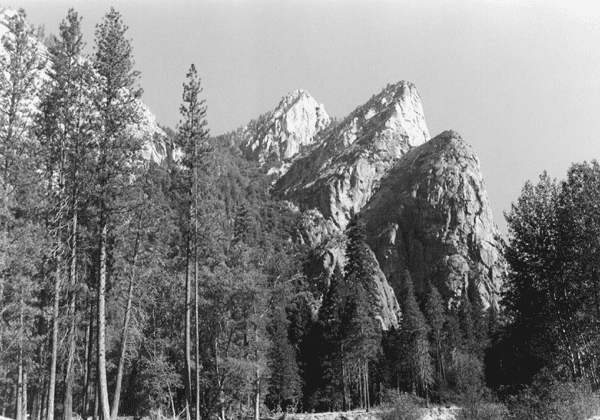
Three Brothers peaks in Yosemite. Image from USGS I-1639.
Whipcords – At audiobook 19:20. A four-stranded braided cord between twine and rope diameter.
Millerton – At audiobook 21:13. A town located on the San Joaquin River north of what is now Fresno, eventually abandoned and now inundated by Millerton Lake, California.
Ambuscade – At audiobook 27:20. An ambush, or surprise attack from concealment.
Piazza post – At audiobook 33:35. Piazza meaning plaza or public square. A post and rail structure at the street for securing horses. Of an endless variety of materials and configurations, as shown in the image at right.
Chapter 7 – Around Yosemite Walls October 5, 1864
Yosemite Park founding Act of Congress – At audiobook 03:20. The statute referred to by King is “An Act authorizing a Grant to the State of California of the Yo-Semite Valley, and of the Land embracing the Mariposa Big Tree Grove.” [S. 203; Public Act No. 159]
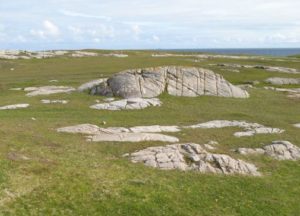
Roche moutonée landscape. From Wikimedia commons.
Black’s Hotel – At audiobook 04:50. Hotel established by A.G. Black in the Coulterville area, which would have been fairly new at the time King stayed there. See a listing for Black’s and other Yosemite hotels at this webpage.
El Capitan – At audiobook 08:15. A sheer-faced, flat-topped peak. King described concentric shells of rock at the top of the mountain unloading (coming loose) in sheets, a geologic process now called “exfoliation.” The USGS excellent and readable webpage on the bedrock geology of the Yosemite explains it: “…in a massive rock monolith, the stresses accumulate until they exceed the tensile strength of the rock, and the outer and more rapidly expanding layer bursts loose. In the course of time the process is repeated, and the monolith becomes covered with several layers of shells.” USGS I-1639.
Three Brothers – At audiobook 21:45. Three clustered mountain peaks in the Sierra Range.
Chaining – At audiobook 21:50. Chaining is the oldest method of surveying based on running a long ‘chain’ between known boundary points in a framework of horizontal lines. Chain is now “tape” as in tape measure. Irregular features outside the boundary can be measured by the its offset distance from the chain line at intervals. For an excellent beginner’s video, see this one by the Royal Scotland survey.
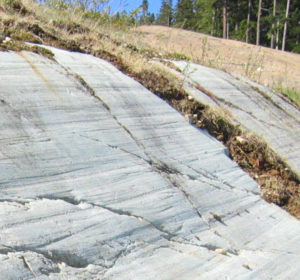
Glacial striations. Image from wikimedia commons.
Roches moutonnée – At audiobook 29:10. Glacier-scoured rock formations. Old French meaning “roche” rock and “mouton” sheep, moutonee meaning visually sheep-like (in shape and texture). See this article for more discussion on its appearance.
Ice striae – At audiobook 33:43. Striations (straie) are long grooves that are produced by glacial pressure and movement over rock as it carries gravel or rock in its base. Geologists can tell the direction that a glacier moved by the direction of striae. This feature can be found in many northern states, but a National Natural Landmark for glacial striae is in Ohio.
Chapter 8 – A Sierra Storm
The Obelisk – At audiobook 00:20. A granite monolith at 9,700 ft ASL. The Obelisk is in modern King’s Canyon National Park and is accessible only to technical climbers. This feature is what King and Cotter intended to climb, but were turned back by the Sierra storm. The Obelisk is featured on the Albert Bierstadt painting “Valley of the Yosemite 1864”.
Medial moraine – At audiobook 06:22. A line of glacial debris formed in the center where two glaciers meet and continue flowing on together. See this NPS page https://www.nps.gov/articles/lateralmedialmoraines.htm . King and Cotter used this long, symmetrical line of boulders as a lifeline to find their way downslope in a blinding Sierra blizzard.
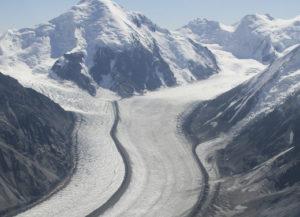
A medial moraine streaks down the center of a glacier, formed of rock debris where two glaciers meet
Snow avalanches – At audiobook 22:17. King describes thunderous snow avalanches from El Capitan, Cathedral, and Three Brothers. The video below is similar to what King would have witnessed. (Video clip runs 35 seconds with audio)
Pyroligneous acid – At audiobook 26:06. In the audio book at (time), pyroligenous acid is also known as “wood vinegar,” an acidic substance expressed from the fire distillation (chemical cracking) of organic hardwood. The liquid was in King’s time used as a mild preservative and anti-microbial. It’s still manufactured today for various uses.
Clark’s Ranch – At audiobook 30:50. Also known as Clark’s Station. Established by Galen Clark, one of the first permanent white residents and an advocate for the establishment and preservation of Yosemite, the location is now known as Wawona, California inside the park boundary. King knew Clark very well, and the station was a common jumping-off point. See also Clark’s book (1910).
Blazed trees – At audiobook 40:08. Blazing is the practice of signaling a trail or survey point by permanently hacking a symbol or exposure into a living tree. See BLM webpage. This is the origin of the term “trail blazing.” Along with rock piles or solid stone monuments, blazing was a common surveying method.
Saleratus – At audiobook 50:16. An English word from the Latin sal æratus, meaning aerated salt. King commented that the biscuits had too much saleratus when at the Chowchilla ranch house into which they barged after crossing the flooded creek. Saleratus is now commonly known as baking soda.
Chapter 9 – Merced Ramblings
Mount Bullion – At audiobook 00:55. A peak named after a Missouri Senator Thomas “Old Bullion” Benton who in the 1830-1940s both promoted the gold standard and homesteading to settle the West. “Bullion” is the nickname for Benton and also references the gold-bearing deposits at the mountain
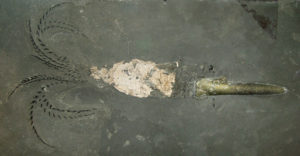
Belemnitida
Cephalopoda – At audiobook 06:05. The class of cephalopoda that King discovered was likely a Belemnitida, (in photo at right) a soft-bodied, squid-like creature whose harder rostrum (shell) often survives fossilization and resembles a small cigar shape. King describes the soft upper body shape as well, an even more rare specimen. This find would have given a geologic age to the gold-bearing dirt of California.
White, infusorial silica – At audiobook 20:55. Now called diatomite, or “diatomaceous earth.” King describes this geologic layer near the surface in the Colombia River basin through which he traveled. Then and now, diatomaceous earth is a valuable natural resource for industrial use, such as natural pesticides, polishing compound, etc.
Disjecta membra – At audiobook 21:40. Latin for scattered or disjointed parts of things.
Basalt flows of Idaho – At audiobook 22:45. The thick layers of basalt described by King are part of the Columbia River basalt, a vast, deep outpouring of lava that covered a vast area of Idaho, Washington, and Oregon. The origin of the basalt was a supervolcano atop a continental hotspot at a subduction zone. The hotspot moved steadily northeastward over the millennia until it is now underneath Yellowstone National Park, making the geologic geyser features we now see.
40th Parallel Survey – At audiobook 25:40. In the book, King describes himself in October 1868 within a corps of a geological survey of the 40th parallel. To 1870s citizens, they would have known King as the leader of the survey, not just a member, as he mentions modestly. Clarence King would have been as instantly recognized in the news as would Elon Musk today. The Fortieth Parallel Survey was funded by Congress to complete gaps in our knowledge of the West along with other major surveys of the era: the Powell, Hayden, and Wheeler. Timothy O’Sullivan, a noted Civil War photographer, was the King survey’s photographer. Other future luminaries of science participated: S.F. Emmons, O.C. Marsh, Sereno Watson, Robert Ridgway, and geologist Arnold Hague, who went on to study and map the Yellowstone area for decades.
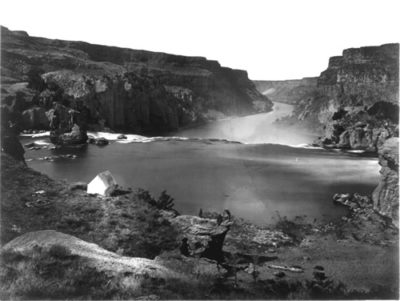
Shoshone Falls, by Timothy O’Sullivan, an actual 1868 photograph from the survey, and showing Clarence King’s tent. Image from the Library of Congress.
Falls near Rock Creek on the Snake River, Idaho – At audiobook 27:20. King compares various falls in the U.S. The location of the Snake River falls that King describes in the middle of the sage scrub desert is Shoshone Falls. It was photographed and documented in King’s report on the 40th Parallel Survey. The map inset below confirms the audiobook description: a bowl-like basin, a sharp drop into the river, and a camping ridge with a right-angle hill like the corner of a room just east of the Falls. Below, a photograph by O’Sullivan showing King’s small camping tent that he describes in his text (audiobook 30:55) as “pitched upon the edge of a cliff, directly overhanging the rapids.”
Barbette batteries – At audiobook 36:35. a curved protective structure surrounding large guns firing over a platform instead of through a window. Modern tanks have turrets surrounding a tank gun, which derived from these batteries.
Temple transit – At audiobook 52:57. This surveying instrument made by T.H. Temple, Boston, was generally known as a theodolite, was mounted on a tripod with extendable legs, and measured horizontal and vertical angles of terrain. King’s usage is the same as saying “an Apple computer” where the maker’s name is bound to its features and use.
Chapter 10 – Cut-Off Copples’s
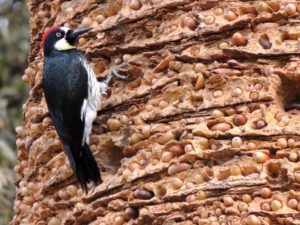
The Acorn Woodpecker foraging and drilling habits, as described by King. This photo from birwatchers.com and copyright by Greg Thomas, 2015
Woodpeckers and acorns – At audiobook 01:15. King is describing the habits of the California “Acorn woodpecker,” a particular bird different from the Midwestern or eastern variety. This woodpecker buries acorn nuts in tree bark, as shown in the photo at right.
Ruskin – At audiobook 03:10. John Ruskin was an English art critic in King’s time, whose name would have been as familiar as film critics today. Ruskin wrote articles and opinions that would have been familiar to most middle and upper class reading public. Ruskin had an affinity for nature and its honesty in art.
Hank G. Smith – At audiobook 06:45. This person did exist but never became a famous artist as he dreamed. No museum has record if his works. The closest sale of any artwork is a recent, unathenticated 2015 auction of a sketch-book of a few pencil drawings, including mule trains, and signed by H. G. Smith.
Bierstadt – At audiobook 09:55. Albert Bierstadt was a gifted and popular painter of romantic western mountain landscapes.
Mule trains and teamsters – At audiobook 10:40. A mule train was generally more than 8 mules teamed together in harness as pack animals or to pull wagon loads. Teamsters, also then known as muleskinners, were the drivers of teams of mules or horses, as described in King’s book. More photos and description are on the Death Valley NP webpage.
Mr. Bergh – At audiobook 17:30. King’s reference is to Henry Bergh, a well-known figure in King’s time, was the founder of the American Society for the Prevention of Cruelty to Animals (ASPCA). The teamster’s humane handling of the animals after the frantic whiplashing by the team’s driver would have been a striking example of ASPCA arguments for better treatment of working animals.
Howells’s “Mrs. Johnson” – At audiobook 21:50. King refers to a story in the Atlantic Monthly (Jan 1868) by W.H. Howells called “Mrs. Johnson,” a spunky and intelligent Black cook who took over a household kitchen in shambles and was gifted at cookery.
Chapter 11 – Shasta
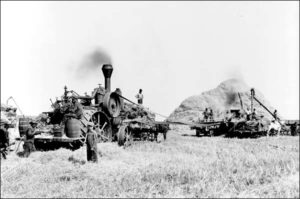
A steam-powered thresher. Image from the U.S. Natural Resources and Soil Conservation gallery. Click image for large view.
Steam-reaper – At audiobook 00:25. King references the steam-powered thresher, shown in photo at right.
Ruth – At audiobook 00:30. King here references the biblical story of the widow Ruth, who gleaned fallen wheat in the fields and attracted the attention of the wealthy landowner Boaz, who eventually married her.
Pitt Ferry – At audiobook 07:45. Ferries across California rivers were an important transportation link, and often towns grew up around them. See image of Pitt Ferry on this webpage.
Sisson’s – At audiobook 12:50. Early settler Justin Sisson had established a base to take tourists and mountaineers onto Mount Shasta. Later this camp and surrounding ranches became the town of Mount Shasta, California.
Munger’s easel – At audiobook 13:20. This is Gilbert Munger, a landscape artist. King published several of Munger’s drawings in his geologic and survey reports.
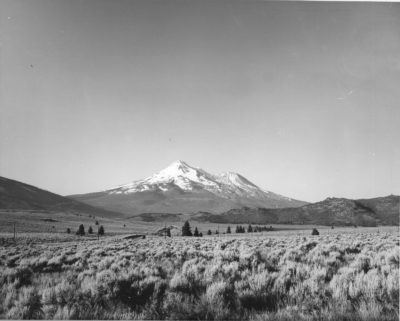
As King would have viewed the Shasta Valley in Siskiyou County, California (audiobook 11:50). Looking south at Mount Shasta. Range cover in the foreground consists of Big Sagebrush clumps with an understory of wheatgrass and some scattered ponderosa pine trees.
Shasta extinct volcano – At audiobook 14:55. A geologic description of this stratovolcano is found at the USGS webpage. A brief fact sheet on Shasta and its history is also here (.pdf).
Sérac – At audiobook 20:47. A serac is a large pinnacle of ice standing on a glacier. For photographs, see this webpage.
Lowell – At audiobook 25:10. “Had Lowell been in our bivouac…” refers to James Russell Lowell, a popular poet and editor of the Atlantic Monthly. The line King quotes comes from Lowell’s earth-textured poem “The Vision of Sir Launfal.” The full poem can be heard on Librivox.org at the following link:
Fur bags – At audiobook 25:41. Sleeping bags of the 19th century made of sheepskin, bearskin, and other fur and leather materials, designed to roll up for portability.
Scoria ridge – At audiobook 29:00. Scoria is a lightweight, bubble-filled lava rock of a dark black or red color. King noted that he was climbing among scoria of all various sizes.
Girls who climbed Shasta – At audiobook 30:00. King may have been referring to Mary A. White who on September 9, 1856, at 21 years old and with a 6 month-old-baby at home, was the first woman to summit Mount Shasta, followed the same day by Harriette C. Eddy, Mrs. McCloud, Mrs. Ross, and Mrs. Gage, along with men on a climb organized by Captain Pierce, all of the Siskiyou region. For a more recent blog post about climbing Mount Shasta, see https://www.earthmagazine.org/article/travels-geology-climbing-mount-shasta.
Névé – At audiobook 34:51. Névé is partially melted and compacted snow that has a density of at least 500 kilograms per cubic meter. Over many freeze-thaw cycles, it becomes glacial ice that feeds the movement and build of a glacier.
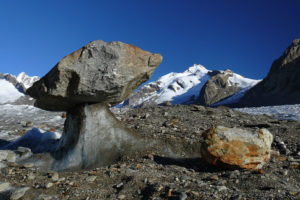
Glacier table. Image from NASA Earth Observatory collection. ©2010 Florian Mair
Glacier tables – At audiobook 47:24. A feature with a stone table top and an ice pedestal caused by the rock’s shading and preventing melt underneath. The surrounding ice shrinks and results in a table formation.
Chapter 12 – Shasta Flanks
Remember Balaam – At audiobook 03:21. From the Old testament Bible story in Numbers 22:21, in which Balaam beats his donkey 3 times for turning away from an angel who had come to turn Balaam away from a reckless course of action. The donkey talks to Balaam, asking if he (the donkey) had ever beaten Balaam this way?
Munger and Watson photos of Mount Whitney – At audiobook 05:00. Photos taken by Carleton Watkins and drawings by Munger populated the scientific reports of the peaks and glaciers around Shasta. An historic Watkins photo of glacier explorations by King’s team is published in the modern USGS circular C-1050.
Trains of stone – At audiobook 06:22. Boulder trains are massive stones left behind by receding glaciers, often in long “trains” or pathways. As a glacier melts, it leaves behind the boulders, rock, and sand it carries underneath and at its leading terminal edge.
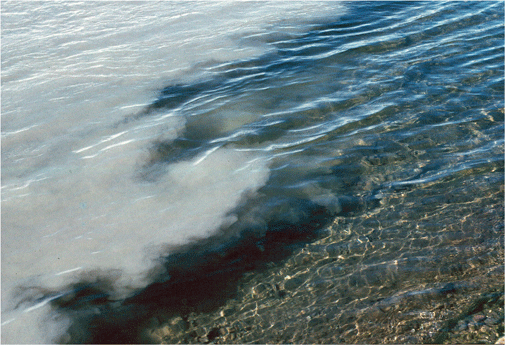
The milky cascades described by King are called rock flour. Image from USGS 2004-1216 Glossary of Glacial Terminology.
Milky cascades from glacier – At audiobook 15:23. What King describes is now called “rock flour,” or the finely ground rock sediment that is suspended in glacial outwash water, and appears like milk.
Black Cone – At audiobook 29:08. Now named Black Butte and formerly Muir’s Peak. A volcanic cinder cone near Mount Shasta, the relationship and flow fields best seen from this NASA aerial view of Mount Shasta and Black Butte cinder cone.
Lava tube – At audiobook 36:19. The tubular lava cave visited by Clarence King and Prof Whitney still exists, and is part of the Lava Beds National Monument now. See this National Park webpage for additional lava tube photographs.
Whitney’s Geological Report – At audiobook 38:07. This is the classic “The Yosemite Guide-Book” published in 1870 by Josiah D. Whitney of the California Geological Survey. Photographs were included by Watkins, lists of Indian names for features, distances by horseback, and descriptions of places long gone and geologic features as yet unnamed.
Cotopaxi – At audiobook 39:07. Cotopaxi, a volcanic peak in South America, was the subject of important works by painter Frederic Edwin Church in 1855 and 1862.
Chapter 13 – Mount Whitney
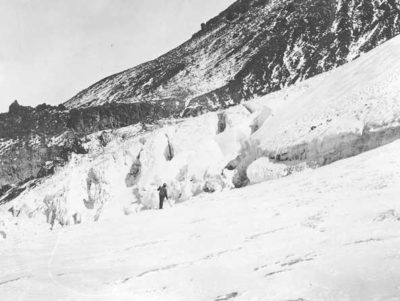
King discovered and explored Whitney Glacier on Mount Shasta, 1870. Photo from Western Region Outreach, USGS.
Stagecoach – At audiobook 00:23. In King’s time, public transportation and mail /small package delivery between waypoints (stages) was accomplished by stagecoach, a horse-drawn vehicle that seated 4-6 people (a coach) and powered by 4-8 horses or mules. See the wikipedia page on stagecoach. King was traveling between points by public stage. The stagecoach era lasted well into the age of railways until personal automobiles and buses became practical for small groups. The stagecoach era gave us the terms “driver” meaning one who steered and controlled the power of the transportation, “coach” class, and “riding shotgun” which was the person who sat next to the driver with weapon to protect the stagecoach.
Aurora – At audiobook 04:25. King was traveling to and overnighted at Aurora, Nevada, then a bustling town of thousands, now a ghost town.
Inyo House at Independence – At audiobook 14:30. Richard Hilton, a blacksmith from Michigan, owned the Inyo House hotel at Independence, and sold in 1870 and the name was changed.
Chapter 14 – The People
Madam Saint John – At audiobook 00:41. A popular medium in King’s time who claimed to predict the future.
Golden curtain of ’49 – At audiobook 01:22. The California in the gold rush of 1849. The ’49ers are also described in this chapter at 14:51.
Mr. Bret Harte – At audiobook 02:51. Bret Harte was a early California newspaperman at San Francisco daily The Golden Era, criticizing slaying of American Indian peoples. Later as a novelist, to which King refers, he specialized in vibrant, gritty stories about California Gold Rush miners, gamblers, and ne’er-do-wells.
Melpomene’s face – At audiobook 04:21. A mask defines the image of Melpomene, the Greek goddess of tragedy in art, song, and dance.
Ci devant advocate– At audiobook 07:10. From the French, meaning “from before”. In King’s narrative, the advocate (lawyer) was described thus, giving the impression that he was detached from the current respectable norms of lawyering back East.
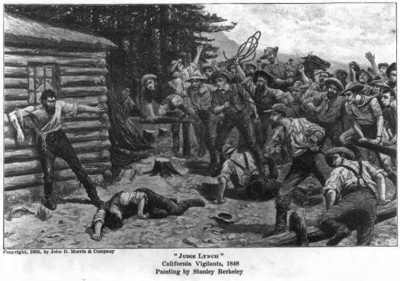
Judge Lynch depicted as a Viligance Committee in a illustration by Stanley Berkeley. Image from Library of Congress.
Masticating – At audiobook 08:53. Masticating means chewing or eating.
Vigilance Committees – At audiobook 09:26. Local posses and mob justice in the West.
State troops at Amador – At audiobook 12:34. In June 1871, the Miner’s League went on strike at Amadour, California for wages, and which the State militia and Governor Haight attempted to quell. King spells it “Armadour” in the book.
Cannon-ball in Boston bricks – At audiobook 14:56. The brick Brattle Street Church in Boston, Massachusetts had a 1775 Revolutionary War British cannon ball cemented into an upper wall in 1824 as a symbol of the church’s role in American history. King makes reference to America’s “youthful past” given that the Revolutionary War not 100 years past at the book’s publishing, and Americans had relatively few historic artifacts to preserve.
Spunge – At audiobook 17:26. Used as a verb. Spunge was a key character in Frederick Reynolds’ 1797 popular stage comedy “Cheap Living,” in which Spunge is a swindler, tricking innocents into giving him money and comfort. “Spunge” thus became both a noun and verb in common usage, being synonymous with duplicity, scamming, and petty theft.
Austrian George – At audiobook 20:14. A contemporaneous news reference. Austrian George Sharkovitch, was a miner near Oroville, California who had murdered a young woman who spurned him. He was caught and killed by a vigilante mob on June 17, 1871 and his remains burned by the mob. King was drawing a comparison between an “auto da fé,” or burning of a heretic by the Inquisition, and the similar mob justice of this frontier event.
END
